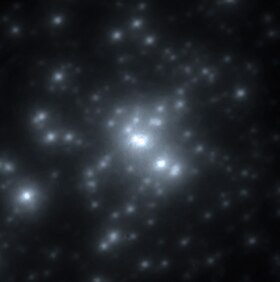
Back R136a1 Afrikaans R136a1 Arabic R136a1 Byelorussian আর১৩৬এ১ Bengali/Bangla R136a1 Catalan ئاڕ١٣٦ئەی١ CKB R136a1 Czech R136a1 German R136a1 Spanish آر۱۳۶ای۱ Persian
| Observation data Epoch J2000.0 Equinox J2000.0 | |
|---|---|
| Constellation | Dorado |
| Right ascension | 5h 38m 42.39s[1] |
| Declination | −69° 06′ 02.91″[1] |
| Apparent magnitude (V) | 12.23[1] |
| Characteristics | |
| Evolutionary stage | Wolf–Rayet star |
| Spectral type | WN5h[2] |
| B−V color index | 0.03[1] |
| Astrometry | |
| Distance | 163,000 ly (49,970[3] pc) |
| Absolute magnitude (MV) | −8.18[4] |
| Details | |
| Mass | 196+34 −27[5] M☉ |
| Radius | 42.7[6] R☉ |
| Luminosity | 4,677,000[5] L☉ |
| Surface gravity (log g) | 3.65[6] cgs |
| Temperature | 46,000+1,250 −2,375[6] K |
| Rotational velocity (v sin i) | 160[6] km/s |
| Age | 1.14+0.17 −0.14[6] Myr |
| Other designations | |
| Database references | |
| SIMBAD | data |
R136a1 (short for RMC 136a1) is one of the most massive and luminous stars known, at nearly 200 M☉ and nearly 4.7 million L☉, and is also one of the hottest, at around 46,000 K. It is a Wolf–Rayet star at the center of R136, the central concentration of stars of the large NGC 2070 open cluster in the Tarantula Nebula (30 Doradus) in the Large Magellanic Cloud. The cluster can be seen in the far southern celestial hemisphere with binoculars or a small telescope, at magnitude 7.25. R136a1 itself is 100 times fainter than the cluster and can only be resolved using speckle interferometry.
- ^ a b c d Doran, E. I.; Crowther, P. A.; de Koter, A.; Evans, C. J.; McEvoy, C.; Walborn, N. R.; Bastian, N.; Bestenlehner, J. M.; Gräfener, G.; Herrero, A.; Kohler, K.; Maiz Apellaniz, J.; Najarro, F.; Puls, J.; Sana, H.; Schneider, F. R. N.; Taylor, W. D.; van Loon, J. Th.; Vink, J. S. (2013). "The VLT-FLAMES Tarantula Survey - XI. A census of the hot luminous stars and their feedback in 30 Doradus". Astronomy & Astrophysics. 558: A134. arXiv:1308.3412. Bibcode:2013A&A...558A.134D. doi:10.1051/0004-6361/201321824. S2CID 118510909.
- ^ Hainich, R.; Rühling, U.; Todt, H.; Oskinova, L. M.; Liermann, A.; Gräfener, G.; Foellmi, C.; Schnurr, O.; Hamann, W. -R. (2014). "The Wolf–Rayet stars in the Large Magellanic Cloud". Astronomy & Astrophysics. 565: A27. arXiv:1401.5474. Bibcode:2014A&A...565A..27H. doi:10.1051/0004-6361/201322696. S2CID 55123954.
- ^ Pietrzyński, G; D. Graczyk; W. Gieren; I. B. Thompson; B. Pilecki; A. Udalski; I. Soszyński; et al. (7 March 2013). "An eclipsing-binary distance to the Large Magellanic Cloud accurate to two per cent". Nature. 495 (7439): 76–79. arXiv:1303.2063. Bibcode:2013Natur.495...76P. doi:10.1038/nature11878. PMID 23467166. S2CID 4417699.
- ^ Bestenlehner, Joachim M.; Crowther, Paul A.; Caballero-Nieves, Saida M.; Schneider, Fabian R. N.; Simón-Díaz, Sergio; Brands, Sarah A.; De Koter, Alex; Gräfener, Götz; Herrero, Artemio; Langer, Norbert; Lennon, Daniel J.; Maíz Apellániz, Jesus; Puls, Joachim; Vink, Jorick S. (2020). "The R136 star cluster dissected with Hubble Space Telescope/STIS. II. Physical properties of the most massive stars in R136". Monthly Notices of the Royal Astronomical Society. 499 (2): 1918. arXiv:2009.05136. Bibcode:2020MNRAS.499.1918B. doi:10.1093/mnras/staa2801.
- ^ a b Cite error: The named reference
Kalariwas invoked but never defined (see the help page). - ^ a b c d e Brands, Sarah A.; de Koter, Alex; Bestenlehner, Joachim M.; Crowther, Paul A.; Sundqvist, Jon O.; Puls, Joachim; Caballero-Nieves, Saida M.; Abdul-Masih, Michael; Driessen, Florian A.; García, Miriam; Geen, Sam (2022-02-01). "The R136 star cluster dissected with Hubble Space Telescope/STIS. III. The most massive stars and their clumped winds". Astronomy & Astrophysics. 663: A36. arXiv:2202.11080. Bibcode:2022A&A...663A..36B. doi:10.1051/0004-6361/202142742. S2CID 247025548.
